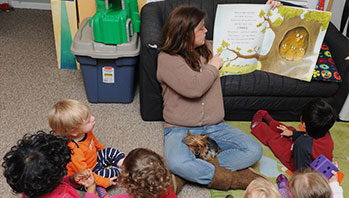- chart paper
- marker
- listen
- predict
- soft
- sound
- whisper
MA Standards:
Literature/RL.PK.MA.1: With prompting and support, ask and answer questions about a story or a poem read aloud.
Literature/RL.PK.MA.7: With prompting and support, make predictions about what happens next in a picture book after examining and discussing the illustrations.
Literature/RL.PK.MA.9: With prompting and support, make connections between a story or poem and one’s own experiences.
Head Start Outcomes:
Literacy Knowledge/Book Appreciation and Knowledge: Asks and answers questions and makes comments about print materials.
PreK Learning Guidelines:
English Language Arts/Reading and Literature 6: Listen to a wide variety of age appropriate literature read aloud.
English Language Arts/Reading and Literature 10: Engage actively in read-aloud activities by asking questions, offering ideas, predicting or retelling important parts of a story or informational book.
Read Together: The Listening Walk #1

© Commonwealth of Massachusetts, Department of Early Education and Care (Jennifer Waddell photographer). All rights reserved.
STEM Key Concepts: Sounds have a source; Sounds vary in three ways: volume, pitch, and timbre; Different objects make different sounds
ELA Focus Skills: Concepts of Print, Interpreting Illustrations, Speaking and Listening, Story Comprehension
Before You Read
Hold up the The Listening Walk by Paul Showers and point to each word as you read aloud the title and the name of the author and illustrator.
Ask children to turn to a partner and describe what they see on the cover. Then say, The title of the book is The Listening Walk.
- What do you think this little girl might do on a listening walk? (listen for sounds)
- What sounds do you predict she might she hear? Why do you think that?
- Do you think she will hear some of the same sounds you heard outside?
As You Read
As you read, pause and ask questions such as,
- Why don’t the girl and her father talk when they go on their listening walk? How does this help them listen?
- What kind voice do you think you will use when you go on a listening walk? (whisper, soft) Why?
After You Read
Ask children to recall some of the sounds the girl hears on her listening walk. Encourage them to act out the sounds.
- If children need support remembering, go through the book page-by-page starting with the sound of the dog’s feet. Ask, What sound does the dog make? How does he make the sound?
- Make a chart of the sounds and their sources. Invite the children to compare the sounds listed to the sounds they heard outside while exploring.
English Language Learners: Name some of the actions in the story, (e.g., walking) and pantomime the action. Have children repeat the action words and pantomime after you.
